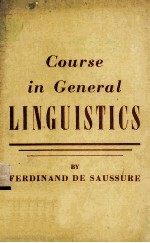

Course in General LinguisticsPDF电子书下载
- 电子书积分:10 积分如何计算积分?
- 作 者:Charles Bally and Albert Sechehaye
- 出 版 社:Peter Owen Limited.
- 出版年份:1959
- ISBN:
- 页数:240 页
INTRODUCTION 1
Chapter Ⅰ.A Glance at the History of Linguistics 1
Chapter Ⅱ.Subject Matter and Scope of Linguistics;Its Relations with Other Sciences 6
Chapter Ⅲ.Object of Linguistics 7
1.Definition of Language 7
2.Place of Language in the Facts of Speech 11
3.Place of Language in Human Facts;Semiology 15
Chapter Ⅳ.Linguistics of Language and Linguistics of Speaking 17
Chapter Ⅴ.Internal and External Elements of Language 20
Chapter Ⅵ.Graphic Representation of Language 23
1.Need for Studying the Subject 23
2.Influence of Writing;Reason for Its Ascendancy over the Spoken Form 23
3.Systems of Writing 25
4.Reasons for the Discrepancy between Writing and Pronunciation 27
5.Results of the Discrepancy 29
Chapter Ⅶ.Phonology 32
1.Definition 32
2.Phonological Writing 33
3.Validity of Evidence Furnished by Writing 34
APPENDIX PRINCIPLES OF PHONOLOGY 38
Chapter Ⅰ.Phonological Species 38
1.Definition of the Phoneme 38
2.The Vocal Apparatus and its Functioning 41
3.Classification of Sounds According to Their Oral Articulation 44
Chapter Ⅱ.Phonemes in the Spoken Chain 49
1.Need for Studying Sounds in the Spoken Chain 49
2.Implosion and Explosion 51
3.Different Combinations of Explosions and Implosions in the Chain 54
4.Syllabic Boundary and Vocalic Peak 57
5.Criticism of Theories of Syllabication 58
6.Length of Implosion and Explosion 60
7.Phonemes of Aperture 4;Diphthongs;Questions about Transcription 60
Editor's Note 62
PART ONE GENERAL PRINCIPLES 65
Chapter Ⅰ.Nature of the Linguistic Sign 65
1.Sign,Signified,Signifier 65
2.Principle Ⅰ:The Arbitrary Nature of the Sign 67
3.Principle Ⅱ:The Linear Nature of the Signifier 70
Chapter Ⅱ.Immutability and Mutability of the Sign 71
1.Immutability 71
2.Mutability 74
Chapter Ⅲ.Static and Evolutionary Linguistics 79
1.Inner Duality of All Sciences Concerned with Values 79
2.Inner Duality and the History of Linguistics 81
3.Inner Duality Illustrated by Examples 83
4.The Difference Between the Two Classes Illustrated by Comparisons 87
5.The Two Linguistics Contrasted According to Their Methods and Principles 90
6.Synchronic Law and Diachronic Law 91
7.Is There a Panchronic Viewpoint? 95
8.Consequences of the Confusing of Synchrony and Diachrony 96
9.Conclusions 98
PART TWO SYNCHRONIC LINGUISTICS 101
Chapter Ⅰ.Generalities 101
Chapter Ⅱ.The Concrete Entities of Language 102
1.Definition of Entity and Unit 102
2.Method of Delimitation 104
3.Practical Difficulties of Delimitation 105
4.Conclusion 106
Chapter Ⅲ.Identities,Realities,Values 107
Chapter Ⅳ.Linguistic Value 111
1.Language as Organized Thought Coupled with Sound 111
2.Linguistic Value from a Conceptual Viewpoint 114
3.Linguistic Value from a Material Viewpoint 117
4.The Sign Considered in Its Totality 120
Chapter Ⅴ.Syntagmatic and Associative Relations 122
1.Definitions 122
2.Syntagmatic Relations 124
3.Associative Relations 125
Chapter Ⅵ.Mechanism of Language 127
1.Syntagmatic Solidarities 127
2.Simultaneous Functioning of the Two Types of Groupings 128
3.Absolute and Relative Arbitrariness 131
Chapter Ⅶ.Grammar and Its Subdivisions 134
1.Definitions:Traditional Divisions 134
2.Rational Divisions 136
Chapter Ⅷ.Role of Abstract Entities in Grammar 137
PART THREE DIACHRONIC LINGUISTICS 140
Chapter Ⅰ.Generalities 140
Chapter Ⅱ.Phonetic Changes 140
1.Their Absolute Regularity 143
2.Conditioned Phonetic Changes 144
3.Points on Method 145
4.Causes of Phonetic Changes 147
5.The Effect of Phonetic Changes Is Unlimited 151
Chapter Ⅲ.Grammatical Consequences of Phonetic Evolution 153
1.Breaking of the Grammatical Bond 153
2.Effacement of the Structure of Words 154
3.There are No Phonetic Doublets 155
4.Alternation 157
5.Laws of Alternation 158
6.Alternation and Grammatical Bond 160
Chapter Ⅳ.Analogy 161
1.Definition and Examples 161
2.Analogical Phenomena Are Not Changes 162
3.Analogy as a Creative Force in Language 165
Chapter Ⅴ.Analogy and Evolution 168
1.How an Analogical Innovation Enters Language 168
2.Analogical Innovations as Symptoms of Changes in Interpretation 169
3.Analogy as a Renovating and Conservative Force 171
Chapter Ⅵ.Folk Etymology 173
Chapter Ⅶ.Agglutination 176
1.Definition 176
2.Agglutination and Analogy 177
Chapter Ⅷ.Diachronic Units,Identities,and Realities 179
Appendices to Parts Three and Four 173
1.Subjective and Objective Analysis 173
2.Subjective Analysis and the Defining of Subunits 185
3.Etymology 189
PART FOUR GEOGRAPHICAL LINGUISTICS 191
Chapter Ⅰ.Concerning the Diversity of Languages 191
Chapter Ⅱ.Complications of Geographical Diversity 193
1.Coexistence of Several Languages at the Same Point 193
2.Literary Language and Local Idiom 195
Chapter Ⅲ.Causes of Geographical Diversity 197
1.Time,the Basic Cause 197
2.Effect of Time on continuous Territory 199
3.Dialects Have No Natural Boundaries 201
4.Languages Have No Natural Boundaries 203
Chapter Ⅳ.Spread of Linguistic Waves 205
1.Intercourse and Provincialism 205
2.The Two Forces Reduced to One 207
3.Linguistic Differentiation on Separate Territories 208
PART FIVE CONCERNING RETROSPECTIVE LINGUISTICS 212
Chapter Ⅰ.The Two Perspectives of Diachronic Linguistics 212
Chapter Ⅱ.The Oldest Language and the Prototype 215
Chapter Ⅲ.Reconstructions 218
1.Their Nature and Aim 218
2.Relative Accuracy of Reconstructions 220
Chapter Ⅳ.The Contribution of Language to Anthropology and Prehistory 222
1.Language and Race 222
2.Ethnic Unity 223
3.Linguistic Paleontology 224
4.Linguistic Type and Mind of the Social Group 227
Chapter Ⅴ.Language Families and Linguistic Types 228
Index 233
- 《哈里森内科学 第19版 双语版 上》(美)丹尼斯·L.卡斯帕(Dennis L. Kasper),(美)安东尼·S.福奇由(Anthony S.Fauci),(美)斯蒂芬·L.豪泽(Stephen L.Hauser)著;王海译 2019
- 《纳尼亚传奇》(英)C.S.刘易斯(C.S.Lewis)著 2019
- 《哈佛极简日本史=THE HERITAGE OF JAPANESE CIVILIZATION 彩插珍藏本》(美)阿尔伯特·克雷格(Albert M.Craig)著 2020
- 《治理、政治与国家=GOVERNANCE》POLITICS AND THE STATE
- 《暗黑之门 历任首相主导下的英国情报史话=SPIES》SECRET INTELLIGENCE AND BRITISH PRIME MINISTERS
- 《石像、神庙与失落的文明:改写世界文明史的玛雅发现之旅=THE EXTRAORDINARY JOUMEY OF JOHN L.STEPHENS AND FREDERICK CSTHERW》AND THE DISCOVERY OF THE LOST CIVILIZATION OF THE MAYA
- 《中国影视娱乐合同范本与风险防范=Chinas Film》Television and Entertainment Industry Contract Model and Risk Prevention
- 《未来的欧洲大战 第3版》S.Fowler Wright著 1938
- 《政治观念史稿·卷一 希腊化、罗马和早期基督教=HISTORY OF POLITICAL IDEAS(VOLUMR 1) HELLENISM》ROME AND EARLY CHRISTIANITY
- 《高瞻课程的理论与实践 科学和技术 关键发展指标与支持性教学策略》(美)安·S.爱泼斯坦(Ann S.Epstein) 2018
- 《从窈窕到苗条 汉学巨擘与诗经楚辞的变译》洪涛著 2013
- 《摆渡船当代世界儿童文学金奖书系 哈尔奇与男孩》(英)温蒂·霍尔登著;许若青译 2018
- 《矿物宝藏》澳大利亚威尔顿·欧文公司编著;黄湘雨译 2016
- 《GERMAN LAW PERTAINING TO COMPANIES WITH LIMITED LIABILITY》 1981
- 《ECOLOGICAL EMERGY ACCOUNTING FOR A LIMITED SYSTEM: GENERAL PRINCIPLES AND A CASE STUDY OF MACAO=有限系统》Kampeng Lei 2014
- 《Limited Budget》 1998
- 《DESIGN IDEAS WITH LIMITED COLOR》 2004
- 《CASES AND MATERIALS ON CORPORATIONS INCLUDING PARTNERSHIPS AND LIMITED LIABILITY COMPANIES ELEVENTH》ROBERT W.HAMILTON 2010
- 《CHILDREN WITH LIMITED ENGLISH:TEACHING STRATEGIES FOR THE REGULAR CLASSROOM》ELLEN KOTTLER 1994
- 《LIMITED LIABILITY COMPANIES FORMATION》OPERATION 2001
